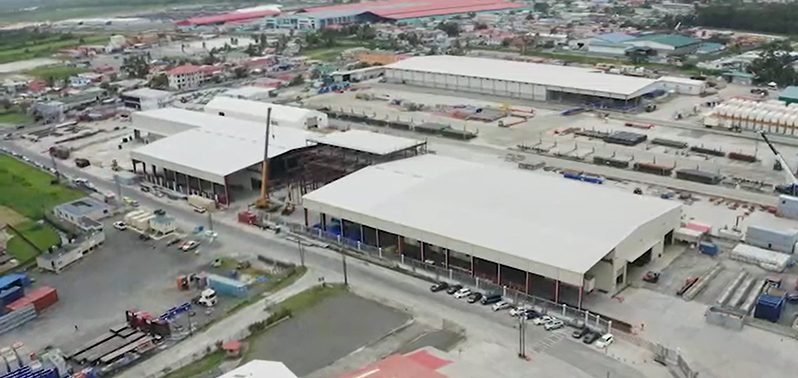–will have G$161M nuclear calibration, storage plant to service oilfield operations
JUST three months after announcing the move of its regional base to Guyana, Schlumberger, one of the world’s leading oil service providers, has wasted no time in initiating efforts to cement its position in the local oil sector, as work is progressing expeditiously on the company’s US$75 million (approximately G$16.1 billion) base at Houston, on the East Bank of Demerara (EBD).

Schlumberger, a renowned Fortune 500 company, is the world’s leading provider of technology and digital solutions for the oil and gas industry. In 2017, this company made a decision to invest significantly and establish a long- term footprint in Guyana.
The oil service provider supports Guyana’s oil and gas exploration and production operations across the entire value chain, from pore to pipeline. But, with ExxonMobil – the key stakeholder in Guyana’s oil and gas sector – set to expand its operations in the near future, Schlumberger has evidently taken steps to ensure that it stays in line with the oil company’s strategic direction.
Phase one of the company’s local development was commissioned in late 2018 and phase two, which includes the construction of a new facility to house the company’s Guyana, Trinidad and the Caribbean (GTC) office, is underway, Managing Director of Schlumberger GTC, Ernesto Cuadros, had said in a previous report.
“We anticipate that this development will be completed in the first half of 2021. Upon completion of phase two, all Schlumberger operations in Guyana will be supported and maintained via our local office by our locally-based team,” Cuadros had said.
In an invited comment to the Sunday Chronicle, the Managing Director revealed that the overall construction of the company’s facility is expected to cost US$75 million. A major component of the company’s new complex is a US$750,000 (approximately G$161 million) nuclear calibration and storage facility, which is under construction at the Houston site.
Schlumberger had submitted an application to the Environmental Protection Agency (EPA) for environmental authorisation for this project.
The EPA, in a notice dated April 11, said that after screening the application to assess the potential environmental impacts, it determined that the project will not significantly affect the environment or human health, so it is exempted from the requirement for an Environmental Impact Assessment (EIA).
However, in keeping with the Environmental Protection Act, Cap.20:05, and the Environmental Protection (Authorisations) Regulations, 2000, any person, who may be affected by the proposed project, may rebut the agency’s decision through a written appeal to the Environmental Assessment Board, within 30 days of the date of the publication of the notice.
In speaking about the intended purpose of Schlumberger’s new facility, Cuadros told the Sunday Chronicle: “Some of our drilling tools use small radioactive sources, approximately the size of an AA battery. These sources help the tools image the ground around them, similar to how a medical X-Ray works. This is common practice in the oil field and these tools are safely used in our operations worldwide.”
He related that strict standards govern how the company uses, stores and monitors those radioactive sources to ensure safety.
“Our internal standards meet or exceed some of the toughest regulatory compliance laws from various countries where we operate. We also have trained employees on site to ensure compliance to these processes,” he related.
By providing this service from Guyana, the company is one step closer to its commitment to operate “for Guyana from Guyana,” bringing to the country additional training and skills that are invaluable to the petroleum sector.
“There has been sporadic exploration activities taking place offshore Guyana for many years, and Schlumberger is proud to have supported those operations. Our activity in the region has accelerated in line with the increase of exploration that began in the early 2000s,” Cuadros had said in a previous report.
The company’s Guyana operations, prior to the now famous Liza Phase One discovery in 2015, were mostly supported by its base in Trinidad and Tobago, while a small team was stationed locally.
Schlumberger’s shift and investment is seen as timely, since it was reported that the year 2021 is shaping up to be significant for exploration and appraisal operations in the Guyana-Suriname basin, with more than 12 exploration and appraisal wells scheduled for Guyana alone.
“Drilling activity in the Guyana-Suriname basin continues to accelerate, driven by the industry’s focus on ‘advantaged barrels as a result of the unique combination of prospect sizes, reservoir quality, low carbon intensity and low breakeven metrics (US$25 to US$35 per barrel), available offshore Guyana,” Westmount Energy had said.
Norwegian independent energy research and business intelligence firm, Rystad Energy, had stated too that 2021 holds “a lot of promise” for Guyana’s burgeoning petroleum sector.
According to Rystad Energy, ExxonMobil, in addition to the Canje Block, will be “firming up” resources in the southeastern part of the Stabroek Block, where deeper plays have been observed underneath the existing discoveries.
The Stabroek Block is 6.6 million acres (26,800 square kilometers), with current discovered recoverable resources estimated at more than nine billion oil-equivalent barrels.
The 19 discoveries on the block to date have established the potential for at least ten floating production, storage and offloading (FPSO) vessels producing more than 750,000 barrels of oil per day by 2027.
ExxonMobil’s first offshore Guyana project, Liza Phase One, began producing in late 2019, well ahead of the industry’s average for development time. Liza Phase Two remains on track to begin producing oil by early 2022. Liza Phase Two will produce up to 220,000 barrels of oil per day at peak rates, using the Liza Unity FPSO. Late last year, the oil giant, following an agreement with the Government of Guyana, decided to proceed with the Payara field development offshore Guyana.
Payara is ExxonMobil’s third project in the Stabroek Block, and is expected to produce up to 220,000 barrels of oil per day, after start-up in 2024, using the FPSO vessel. The US$9 billion development will target an estimated resource base of about 600 million oil-equivalent barrels.
“Rystad Energy data suggests that close to 300 million barrels of oil equivalent have been discovered on average for each exploration well (wildcat and appraisal) drilled in the country over the past six years,” Analyst attached to Rystad Energy’s upstream team, Santosh Kumar, said in a recent report.
According to Westmount Energy, Guyana, with its positive prospects and vast potential, remains one of the few areas of “blue-chip” interest in high-impact exploration. Investopedia defines blue-chip stocks as secure investments because they pay out dividends as well as consistently and steadily grow over time.




.png)









